What's a Cat Show?
A TICA cat show is an event where cats compete to win titles. The cats are evaluated by judges and compared to their respective breed standards. So it is really a "beauty contest". The International Cat Association (TICA) is one of the largest cat fancy associations in the world, and it recognizes over 70 cat breeds - and people can also show their non-pedigreed cats (Household Pets).
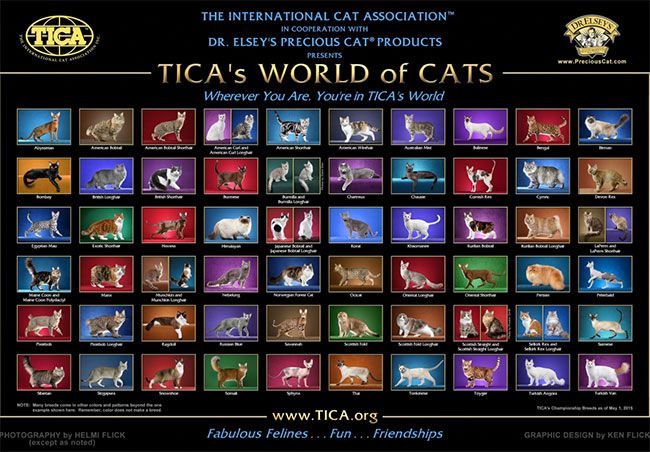 As a visitor to a TICA cat show, you can expect to see a wide variety of cats, from the familiar Persian and Siamese to the more exotic Sphynx or Lykoi.
As a visitor to a TICA cat show, you can expect to see a wide variety of cats, from the familiar Persian and Siamese to the more exotic Sphynx or Lykoi.
In addition to the competition, there are often other events and activities at TICA cat shows, such as educational seminars, adoption events, and cat-themed vendors. So whether you're a cat lover or just curious about these furry creatures, a TICA cat show is a great way to spend a day. Be sure to dress comfortably, as you may be doing a lot of walking.
Finding a Show
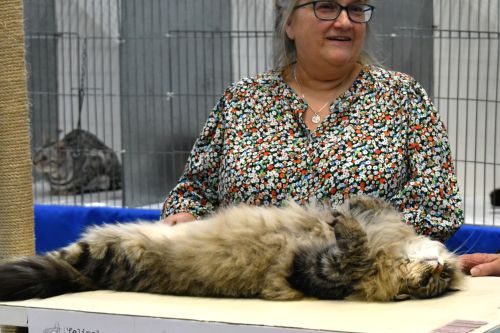 The best place to find an upcoming show is the TICA Cat Show Calendar. It lists all scheduled shows all over the world. To narrow it down to the shows interesting to you, choose Show Additional Filters and select the country or state you are interested in, and choose Apply Filter. Then scroll through the list and choose any of the listed shows to see the details. Right at the top you will find the show hall information, and you can follow a link to find the exact location. A bit further down, you will also find the link to the Show Flyer for the show, which might have additional information like ticket prices.
The best place to find an upcoming show is the TICA Cat Show Calendar. It lists all scheduled shows all over the world. To narrow it down to the shows interesting to you, choose Show Additional Filters and select the country or state you are interested in, and choose Apply Filter. Then scroll through the list and choose any of the listed shows to see the details. Right at the top you will find the show hall information, and you can follow a link to find the exact location. A bit further down, you will also find the link to the Show Flyer for the show, which might have additional information like ticket prices.
Before the Show
Tickets are usually required. They can either be purchased online or at the door. The TICA Cat Show Calendar might have details on that - or use the link to the Show Flyer on the calendar to get additional information.
At the Show
What Is A Judging Ring?
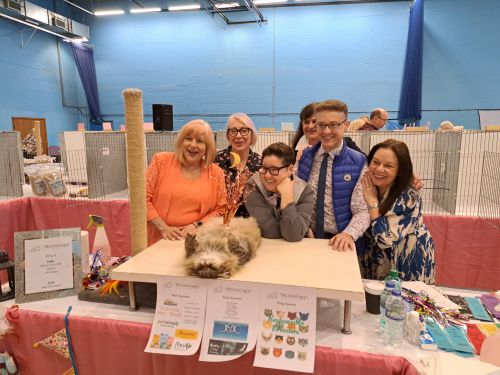 There's a lot going on during a show. Each judge evaluates each cat in their own "ring". This is a special area designated to a specific judge. The exhibitors bring the cats to the different rings when the judge is ready for them. Each ring is basically a separate show. When a judge has judged all the cats in a "class" (e.g. kittens, adults, or alters), they decide which cats to call back for their "Final" where they present the cats they felt came closest to the respective breed standard.
There's a lot going on during a show. Each judge evaluates each cat in their own "ring". This is a special area designated to a specific judge. The exhibitors bring the cats to the different rings when the judge is ready for them. Each ring is basically a separate show. When a judge has judged all the cats in a "class" (e.g. kittens, adults, or alters), they decide which cats to call back for their "Final" where they present the cats they felt came closest to the respective breed standard.
For more information about the judging process, please see What Do Those Ribbons Mean?
Benching Area
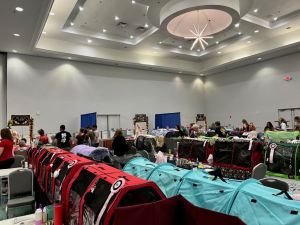 When the cats are not being judged in a ring, they are chilling in the "benching area". They have their own personal cages there and spend the time with their owners. Feel free to approach an exhibitor and ask them about their cat - but take into consideration that they may need to leave for a ring or not have time for you right at that moment.
When the cats are not being judged in a ring, they are chilling in the "benching area". They have their own personal cages there and spend the time with their owners. Feel free to approach an exhibitor and ask them about their cat - but take into consideration that they may need to leave for a ring or not have time for you right at that moment.
Visitor Rules
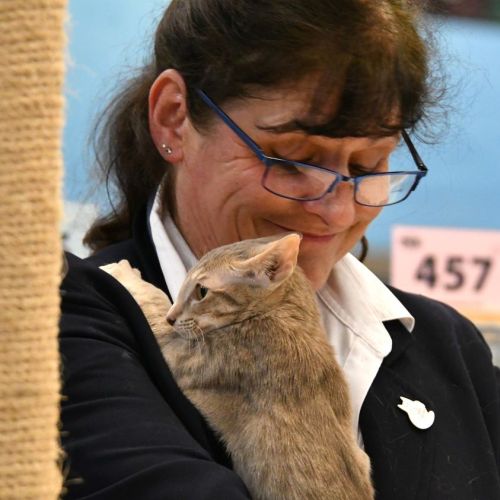 While you are in the show hall, please follow these rules:
While you are in the show hall, please follow these rules:
- Be respectful of the cats and the exhibitors.
- People with cats always have the right of way - please don't stop them in the middle of the show hall. Follow them to the judging ring or the benching area - you can ask them questions once they have arrived where they're going.
- Do not touch the cats without permission from the exhibitor.
- Do not go up to the cages in the judging rings. There are usually chairs in front of each ring. Please watch the judging and the cats from there 😊
- Be quiet and do not make loud noises, as this can upset the cats.
- Do not lean over cages or put your hands into cages.
- Be aware of your surroundings and watch your children closely
How Do I Find the Cats or Breeds I'm Interested In?
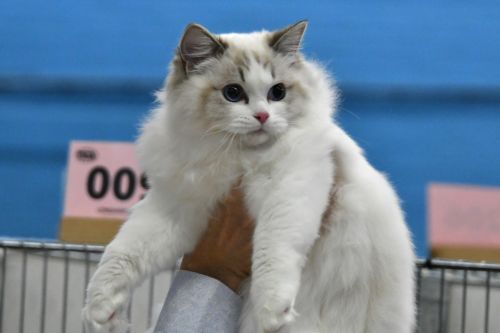 You can always just browse the benching area and what catches your attention. But if you're looking for a specific breed or breeds, the best place to "catch" them is to seek them out in a ring.
You can always just browse the benching area and what catches your attention. But if you're looking for a specific breed or breeds, the best place to "catch" them is to seek them out in a ring.
The club probably has a judging schedule posted somewhere - and possibly also a list of numbers per breed. Let's say you're interested in Bengals, Maine Coons, and Ragdolls. You look at the list and see which numbers they have. There will be separate sets of numbers for kittens, cats, and alters. Some clubs might have an overview posted which numbers go with which breeds. It might look something like this (this is just an example and only covers the kitten class):
| LH Kittens | |
| Breed | Numbers |
| Birman | 1 |
| Himalayan | 2 |
| Maine Coon | 3 - 7 |
| Norwegian Forest | 8 |
| Persian | 9 |
| Ragdoll | 12 - 16 |
| Scottish Fold Longhair | 17 - 18 |
| Scottish Straight Longhair | 19 - 20 |
| Selkirk Rex Longhair | 21 |
| Somali | 22 - 23 |
| Turkish Angora | 23A - 24 |
| SH Kittens | |
| Breed | Numbers |
| Abyssinian | 51 - 54 |
| Bengal | 55 - 63 |
| British Shorthair | 64 - 68 |
| Korat | 70 |
| Scottish Fold | 71 - 72 |
| Toyger | 75 |
So now you check which rings these numbers are posted in, that is, whether there are any rings where these numbers are on the cages. Once you've found a ring with the numbers, you just go there and watch the judge evaluate them.
What Is A Breed Standard?
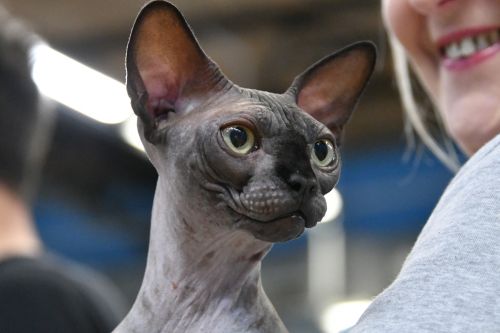 A breed standard is a description of the unique features of each breed. It is a written example of the "perfect" or "ideal" cat of that breed. Once the judge has decided which cats are their best (or 2nd or 3rd) of breed, they decide which cats best meet their standard from all the cats and rank them... aka Finals. If you go to Browse All Breeds on the TICA website, and choose a breed, you can find the breed standard there - as well as some very nice pictures of the respective breeds 😊
A breed standard is a description of the unique features of each breed. It is a written example of the "perfect" or "ideal" cat of that breed. Once the judge has decided which cats are their best (or 2nd or 3rd) of breed, they decide which cats best meet their standard from all the cats and rank them... aka Finals. If you go to Browse All Breeds on the TICA website, and choose a breed, you can find the breed standard there - as well as some very nice pictures of the respective breeds 😊
For more information about the judging process, please see What Do Those Ribbons Mean?
What Do Those Ribbons Mean?
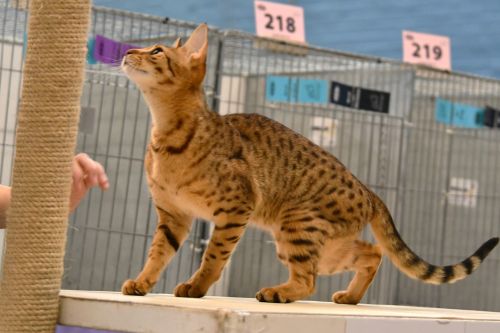 The judging process follows a specific structure.
The judging process follows a specific structure.
The cats are separated into the following classes, which are evaluated separately:
- Kittens (4 - 7 months of age)
- Adults (8 months or older)
- Alters (cats 8 months or older that have been spayed or neutered)
- Household Pet Kittens (non-pedigreed cats, 4 - 7 months of age)
- Household Pets (non-pedigreed cats, 8 months or older)
The judge will evaluate all cats of the same color of the same breed within the same class, e.g. all blue British Shorthair kittens. They will then rank the cats within that group and hang a ribbon or flat on the cage of the cats:
| Color | Place | |
| Blue | 1st | |
| Red | 2nd | |
| Yellow | 3rd | |
| Green | 4th | |
| White | 5th | |
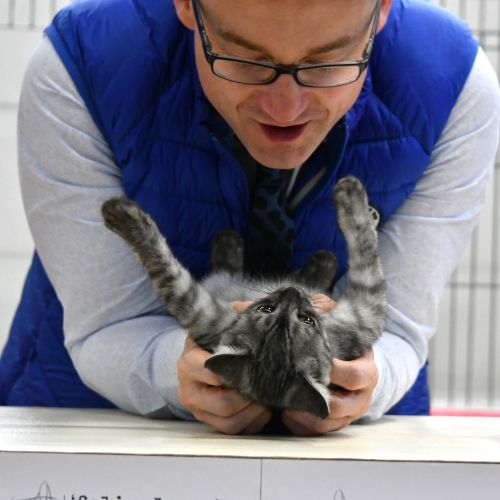 The different colors are grouped into "Divisions". When the judge has evaluated all cats within a division, they will rank the cats for the division and hang a ribbon or flat on the cage of the cats. Of course, their choices for "Best in Division" have to follow the ranking from "Best in Color", e.g. the second best brown classic tabby Maine Coon cannot be "Best in Division" 🙂
The different colors are grouped into "Divisions". When the judge has evaluated all cats within a division, they will rank the cats for the division and hang a ribbon or flat on the cage of the cats. Of course, their choices for "Best in Division" have to follow the ranking from "Best in Color", e.g. the second best brown classic tabby Maine Coon cannot be "Best in Division" 🙂
| Color | Place | |
| Black | 1st | |
| Purple | 2nd | |
| Orange | 3rd | |
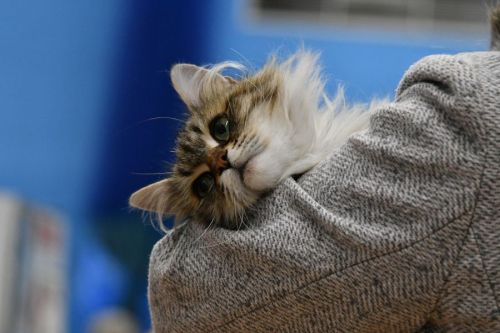 After the judge completes the color and division judging, they may announce or hang the top three Best of Breed. Here, they need to follow their ranking from "Best of Division".
After the judge completes the color and division judging, they may announce or hang the top three Best of Breed. Here, they need to follow their ranking from "Best of Division".
| Color | Place | |
| Gold | 1st | |
| Silver | 2nd | |
| Bronze | 3rd | |
Once the judge has completed judging for a class, they will pick their top 10 Best in Show for their final among their "Best of Breed" Winners. If there are not very many cats in a class, less than 10 places will be awarded in the final.






